2019 MERCEDES-BENZ S-CLASS SEDAN & MAYBACH light
[x] Cancel search: lightPage 195 of 578
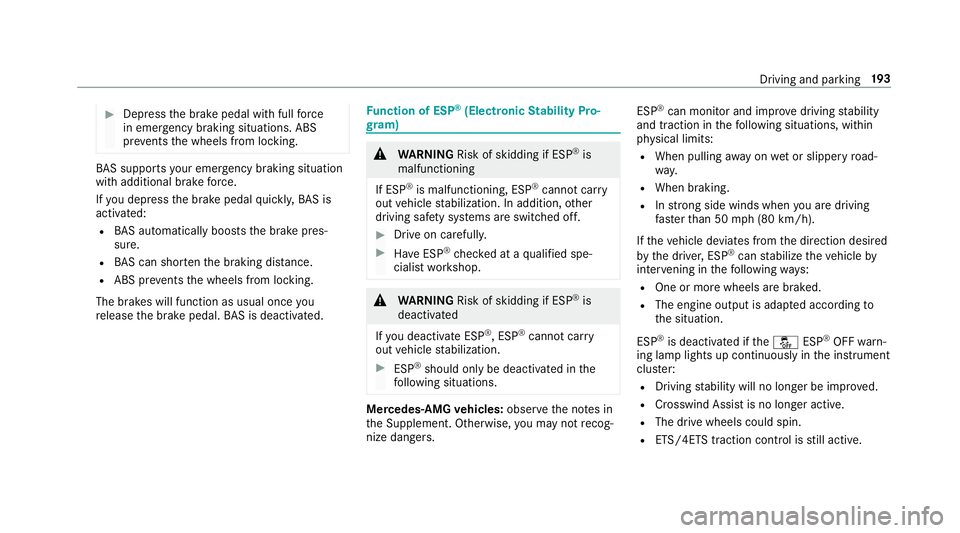
#
Dep ress thebr ak epedal withfull forc e
in emer gency braki ng situa tions. ABS
pr eve nts thewheels from locking . BA
Ssu ppo rts yo ur eme rgency braking situation
wit hadditional brak efo rc e.
If yo udepr essthebr ak epedal quickl y, BA Sis
acti vated:
R BASau tomatical lyboos tsthebr ak epr es‐
sur e.
R BAScan shorten thebr aking distance.
R ABS preve nts thewheels from locking .
The brak es will func tion asusual onceyo u
re lease thebr ak epedal. BASis dea ctivated. Fu
nction ofESP ®
(Electr onicStabil ityPro‐
gr am) &
WARNIN GRisk ofskid ding ifESP ®
is
mal functi oning
If ESP ®
is mal functi oning,ESP ®
canno tcar ry
out vehicle stabiliz ation.Inaddit ion,ot her
dr iving safetysy stems areswitc hedoff. #
Drive on car efull y. #
Have ESP ®
ch eckedat aqu alif ied spe‐
cialis two rkshop. &
WARNIN GRisk ofskid ding ifESP ®
is
dea ctivated
If yo udeac tivateES P®
,ES P®
can notcar ry
out vehicle stabiliz ation. #
ESP®
shoul don lybe deactiv ated inthe
fo llo wing situat ions. Mer
cedes‑AM Gve hicl es:obse rveth eno tesin
th eSupplement .Ot her wise, youma yno tre cog‐
nize dangers. ESP
®
can moni torand improve driving stabilit y
and tract ion inthefo llo wing situat ions,wit hin
ph ysical limit s:
R When pulling away on wetor slip pe ry road‐
wa y.
R When braking.
R Instro ng side winds when youar edr ivin g
fa ster than 50 mph(8 0km/h).
If th eve hicle deviat esfrom thedir ect ion desir ed
by thedr iver ,ES P®
can stabiliz eth eve hicle by
int erve ning inthefo llo wing ways:
R One ormor ewheels arebr ak ed.
R The engine outputisadap tedaccor dingto
th esituation .
ES P®
is deactiv ated ifth e00BB ESP®
OFF warn‐
ing lam plight sup con tinuousl yin theins trument
clus ter:
R Driving stabilit ywill nolongerbe improv ed.
R Crosswind Assistis no long eractiv e.
R The drive wheels couldspin.
R ETS/4 ETStraction control isstill act ive. Dr
ivin gand parking19
3
Page 196 of 578
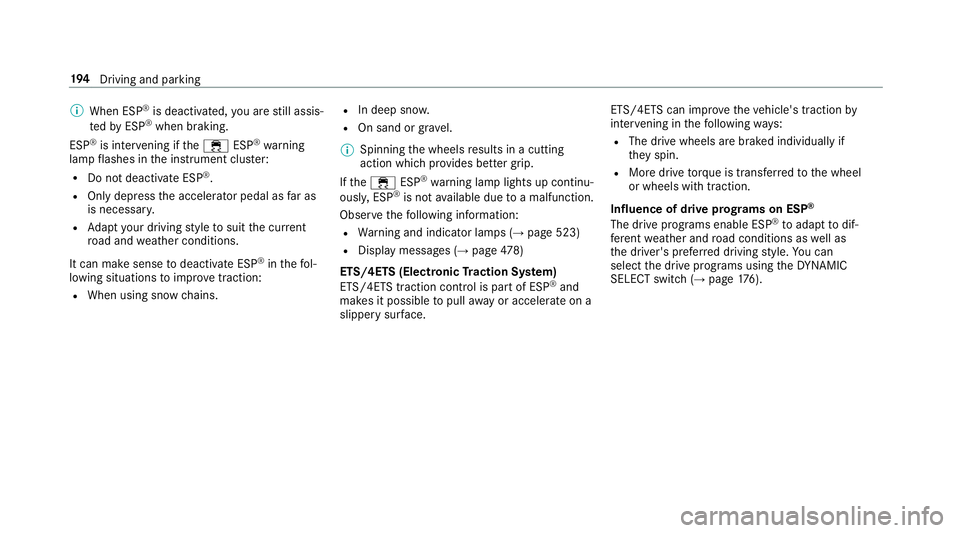
%
When ESP®
is deactiv ated, youar est ill assis‐
te dby ESP ®
wh en braki ng.
ESP ®
is int erve ning ifth e00E5 ESP®
wa rning
lam pflashes intheins trument cluster:
R Donotde acti vate ESP ®
.
R Only depress theaccelera torpeda las faras
is necessar y.
R Adaptyo ur drivin gst yle to suit thecur rent
ro ad and weather condition s.
It can makesen setodeactiv ateES P®
in thefo l‐
lo wing situat ionstoimprove tracti on:
R Whenusing snowch ains . R
Indeep snow .
R Onsand orgrave l.
% Spin ningth ewheels results inacutting
action whichpr ov ides better grip.
If th e00E5 ESP®
wa rning lam plight sup con tinu‐
ousl y,ESP ®
is no tav ailable duetoamalf unction.
Obse rveth efo llo wing informatio n:
R Warning and indic ator lam ps(→ pag e523 )
R Disp lay mess ages (→ pag e47 8)
ET S/4 ETS(E lec troni cTr actio nSy stem)
ET S/ 4ETS tracti oncontr olispa rtof ESP ®
and
mak esitpossible topull away oracceler ateon a
slipper ysur face. ET
S/4ET Scan improve theve hicle's traction by
int erve ning inthefo llo wing ways:
R The drive wheels arebr ak ed individually if
th ey spin.
R Mor edr ive to rq ue istrans ferred tothewheel
or wheels withtra ction.
Inf luence ofdrive pr og rams onESP®
The drive pr og rams enabl eESP ®
to adap tto dif‐
fe re nt we ather and road con dition sas wellas
th edr iver's prefer reddr iving style. Youcan
sele ctthedr ive pr og rams using theDY NA MIC
SELE CTswitc h(→ pag e17 6). 19
4
Driving and parking
Page 197 of 578
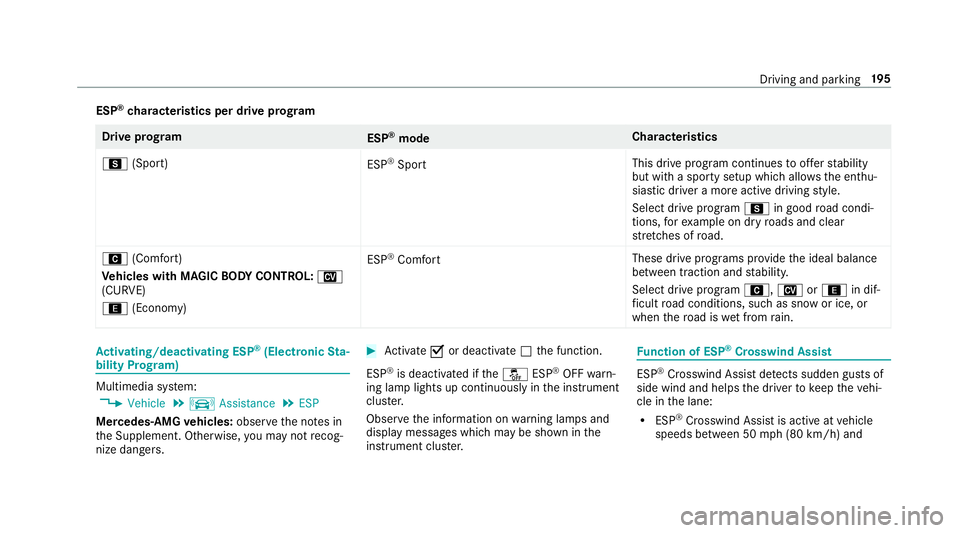
ESP
®
ch aract eristics perdrive pr og ram Dr
ive pr og ram
ESP®
mod e Cha
racter istics
C (Sport)
ESP®
Spo rt This
drive pr ogr am cont inues toofferst abilit y
but withaspor tysetup whic hallo wstheent hu‐
sias ticdriver amor eactiv edr iving style.
Select drive pr og ram C ingood road con di‐
tio ns,fo rex am ple ondryro ads and clear
st re tche sof road.
A (Comf ort)
Ve hicl eswith MAGIC BODY CONT ROL:N
(CUR VE)
; (Econo my) ESP
®
Co mfort The
sedrive pr og rams prov ide theideal balance
be tween traction and stabilit y.
Sel ect drive pr ogr am A, Nor; indif‐
fi cul tro ad con dition s,suc has snow orice, or
when thero ad iswe tfr om rain. Ac
tiv atin g/deac tivatin gES P®
(E lectr onicSta‐
bil ity Prog ram) Mu
ltimed iasystem:
, Vehicle .
k Assist ance .
ESP
Mer cedes‑AMG vehicl es:obse rveth eno tesin
th eSupplement .Ot her wise, youma yno tre cog‐
nize dangers. #
Activate0073 ordeacti vate 0053 thefunc tion.
ES P®
is deactiv ated ifth e00BB ESP®
OFF warn‐
ing lam plight sup con tinuousl yin theins trument
clus ter.
Obser vetheinf ormation onwarning lam psand
displa ymess ages whic hma ybe sho wninthe
ins trumen tclus ter. Fu
nction ofESP ®
Cr osswind Assist ES
P®
Cr osswind Assistde tects sudde ngu stsof
side wind andhelps thedr iver tokeep theve hi‐
cle inthelane:
R ESP®
Cr osswind Assistis activ eat vehicle
speeds between 50mph(8 0km/h) and Dr
iving andparking 19
5
Page 198 of 578
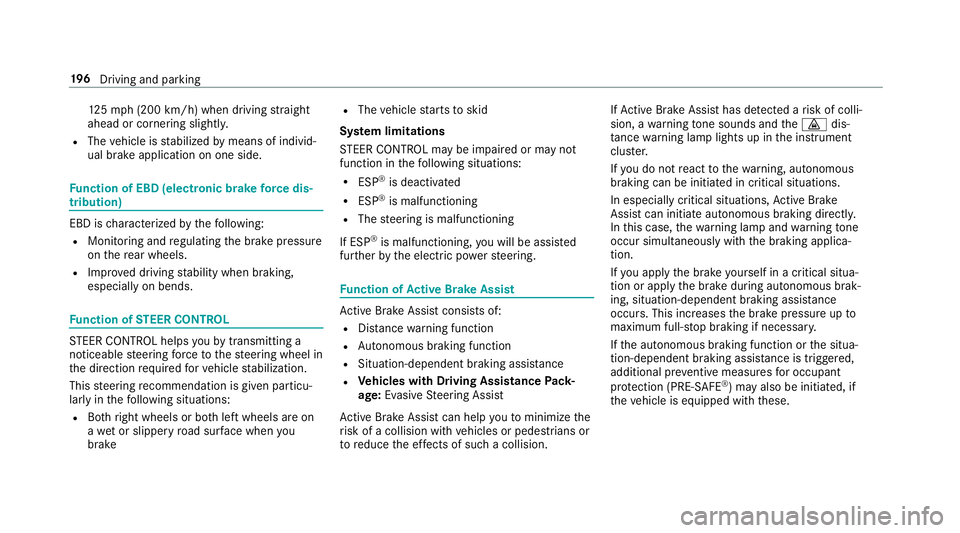
12
5mp h(2 00 km/h) whendr iving stra ight
ahead orcor ner ing slight ly.
R The vehicle isstabiliz edbymeans ofindivi d‐
ua lbr ak eapp lication onone side. Fu
nction ofEBD (electr onicbrak efo rc edis‐
tr ibut ion) EB
Dis ch aract erize dby thefo llo wing:
R Mon itor ing and regulating thebr ak epr essur e
on there ar wheels .
R Improv ed driving stabilit ywhen brakin g,
espe ciallyon ben ds. Fu
nction ofSTEER CONT ROL ST
EER CONTR OLhelpsyo uby trans mitting a
no tice ablesteer ing forc eto thesteer ing wheel in
th edir ect ion requ ired forve hicle stabiliz ation.
This steer ing recomme ndation isgiv en particu‐
lar lyin thefo llo wing situat ions:
R Both right wheels orboth leftwheels areon
a we tor slip pe ry road sur face whe nyo u
br ak e R
The vehicle star ts to skid
Sy stem limita tions
ST EER CONTR OLmaybe impa ired orma yno t
fu nctio nin thefo llo wing situat ions:
R ESP®
is deact ivat ed
R ESP®
is malfun ctionin g
R The steer ing ismalfunct ioning
If ES P®
is malfunct ioning,youwill beassis ted
fur ther by theelectr icpo we rst eer ing. Fu
nction ofActiv eBr ak eAs sist Ac
tiveBr ak eAssi stconsi stsof:
R Distance warning func tion
R Autonomo usbraki ng func tion
R Situ ation-d epend ent braki ng assist anc e
R Vehicl eswith Drivin gAss istanc ePa ck‐
ag e:Evasi ve Steer ing Assis t
Ac tiveBr ak eAssi stcan helpyo uto minimize the
ri sk ofacollision withve hicles orpedes trians or
to reduce theef fects ofsuch acol lision . If
Ac tiveBr ak eAssi sthas detected arisk ofcolli‐
sion, awa rning tone sou nds and the00BA dis‐
ta nce warning lam plight sup intheins trument
clus ter.
If yo udo notre act tothewa rning, autono mous
br akin gcan beinit iated incritic alsituat ions.
In espec iallycritic alsituat ions,Ac tiveBr ak e
Assi stcan initia te aut onomo usbrakin gdir ect ly.
In this case, thewa rning lam pand warning tone
occu rsi mu ltane ously with thebr aking applica‐
tion .
If yo uappl yth ebr ak eyo urself inacr itical situa‐
tio nor appl yth ebr ak edur ing autonomous brak‐
ing, situation -dependen tbr aking assistance
occu rs.Thi sincr eases thebr ak epr essur eup to
maximu mfull -sto pbr aking ifnec essar y.
If th eaut onomous braking function orthesitua‐
tion -dependen tbr aking assistance istrig ge red,
additional prev ent ive measur esforoccupa nt
pr otect ion (PRE-S AFE®
)ma yalso beinitiat ed,if
th eve hicle iseq uipped withth ese. 19
6
Driving and parking
Page 199 of 578
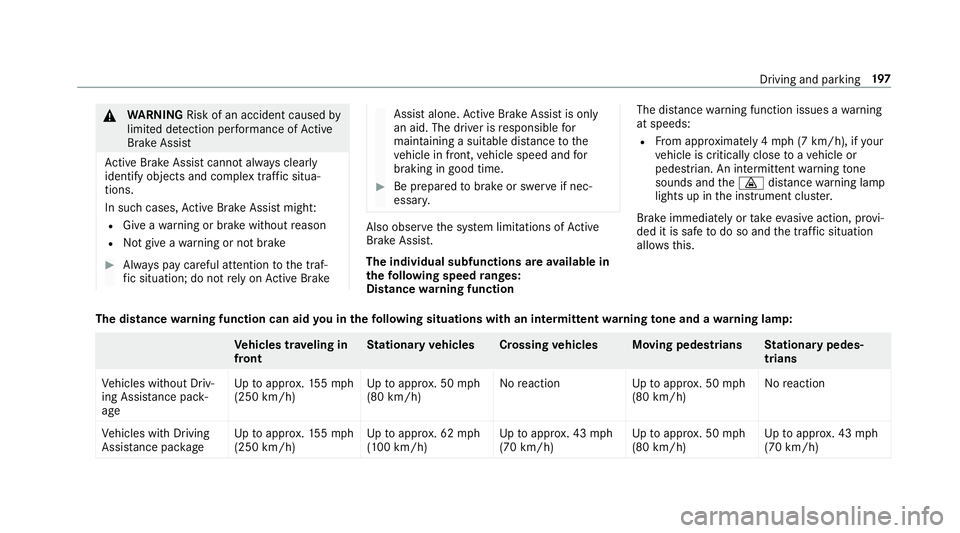
&
WARNIN GRisk ofan acci dent caused by
limit eddetection perform anc eof Active
Br ak eAssi st
Ac tiveBr ak eAssi stcanno tal wa ys cle arly
ident ifyobje ctsand complextraf fic situ a‐
tions .
In such case s,Ac tiveBr ak eAssi stmight :
R Giveawa rning orbrak ewit hout reason
R Notgiv eawa rning ornotbr ak e #
Alw ayspa ycar eful attention tothetra f‐
fi c situ ation; donotre ly on ActiveBr ak e Assi
stalon e.Ac tiveBr ak eAssi stisonl y
an aid. Thedriver isresponsible for
maint ainingasui table distance tothe
ve hicle infront, vehicle speed andfor
br aking ingood time. #
Beprepar edtobrak eor sw erve ifnec ‐
essar y. Als
oob ser vethesy stem limit ations ofActive
Br ak eAssi st.
The indiv idua lsub func tions areav ailab lein
th efo llo wing speed rang es:
Dis tance warning funct ion The
distance warning func tion issues awa rning
at speeds:
R From appr oximat ely4 mp h(7 km/h), ifyo ur
ve hicle iscritically closetoave hicle or
pedes trian. Anintermitt entwarning tone
sou nds and the00BA distance warning lam p
light sup intheins trument cluster.
Br ak eimme diat ely ortake evasiv eact ion,pr ov i‐
ded itis saf eto do soand thetraf fic situ ation
al lo ws this.
Th edis tance warning funct ioncan aidyouin thefo llo wing situations withan intermit tent wa rning tone and awa rning lam p: Ve
hicl estrave ling in
fr ont St
ation aryve hicl es Cross ing vehicl es Moving pedes trians Station arypedes ‐
tr ians
Ve hicles without Driv‐
ing Assis tance pack‐
ag e Up
toappr ox.15 5mp h
(250 km/h) Up
toappr ox.50 mph
(80 km/ h) No
react ion Uptoappr ox.50 mph
(80 km/ h) No
react ion
Ve hicles withDr iving
Assis tance packag e Up
toappr ox.15 5mp h
(250 km/h) Up
toappr ox.62 mph
(1 00 km/ h) Up
toappr ox.43 mph
(70 km/ h) Up
toappr ox.50 mph
(80 km/ h) Up
toappr ox.43 mph
(70 km/ h) Dr
iving andparking 19
7
Page 201 of 578
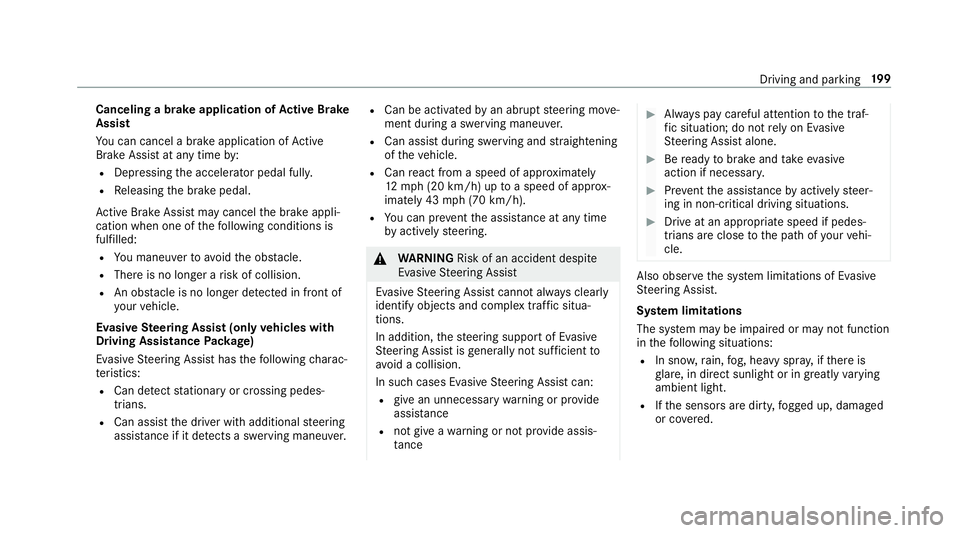
Canceli
ngabr ak eap plica tionofActiv eBr ak e
As sist
Yo ucan cancelabr ak eapplic ationof Active
Br ak eAssi stat anytim eby :
R Dep ressing theaccelera torpeda lfully .
R Releasing thebr ak epedal.
Ac tiveBr ak eAssi stma ycancel thebr ak eappli‐
cation whenoneofthefo llo wing condition sis
fulf illed:
R Youman euvertoavoid theobs tacle .
R The reisno long erarisk ofcollision.
R Anobs tacle isno long erdetected infront of
yo ur vehicle.
Ev asiv eSte ering Assis t(onl yve hicl eswith
Dr ivin gAss istanc ePa ckag e)
Ev asi ve Steer ing Assis thas thefo llo wing charac‐
te rist ics:
R Can detect statio naryor cross ing pedes ‐
tr ians .
R Can assis tth edr iver wit hadditional steer ing
assis tance ifit de tects asw erving mane uver. R
Canbe acti vatedby an abr uptst eer ing move‐
ment during asw erving maneu ver.
R Can assis tdur ing swervin gand stra ight enin g
of theve hicle.
R Can react from aspee dof appr oximat ely
12 mp h(2 0km/h) uptoaspee dof appr ox‐
imat ely43 mph(7 0km/h).
R Youcan preve nttheassis tance atanytime
by act ivel yst eer ing. &
WARNIN GRisk ofan acci dent despite
Ev asive St eer ing Assis t
Ev asiv eSt eer ing Assis tcann otalw aysclear ly
identify objectsandcomplextraf fic situ a‐
tions .
In addition, thesteer ing suppor tof Evasiv e
St eer ing Assis tis ge ner ally no tsu fficien tto
av oid acollision.
In suc hcases Evasiv eSt eer ing Assis tcan:
R givean unnec essarywa rning orprov ide
assis tance
R notgi ve awa rning ornotpr ov ide assis‐
ta nce #
Alw ayspa ycar eful attention tothetra f‐
fi c situ ation; donotre ly on Evasiv e
St eer ing Assis talone. #
Beready tobrak eand take evasiv e
act ion ifnec essar y. #
Preve nttheassis tance byact ivel yst eer‐
ing innon -critical driving situation s. #
Drive at an appr opriatespeed ifpedes‐
tr ians areclose tothepat hof your vehi‐
cle. Also
obser vethesy stem limit ations ofEvasiv e
St eer ing Assis t.
Sy stem limita tions
The system maybe impair edorma yno tfunc tion
in thefo llo wing situat ions:
R Insno w,rain, fog, hea vyspr ay,if th er eis
gl ar e, indir ect sunlight oringrea tly varying
ambien tlight .
R Ifth esensor sar edir ty,fo gg ed up, damag ed
or covered. Dr
iving andparking19
9
Page 203 of 578
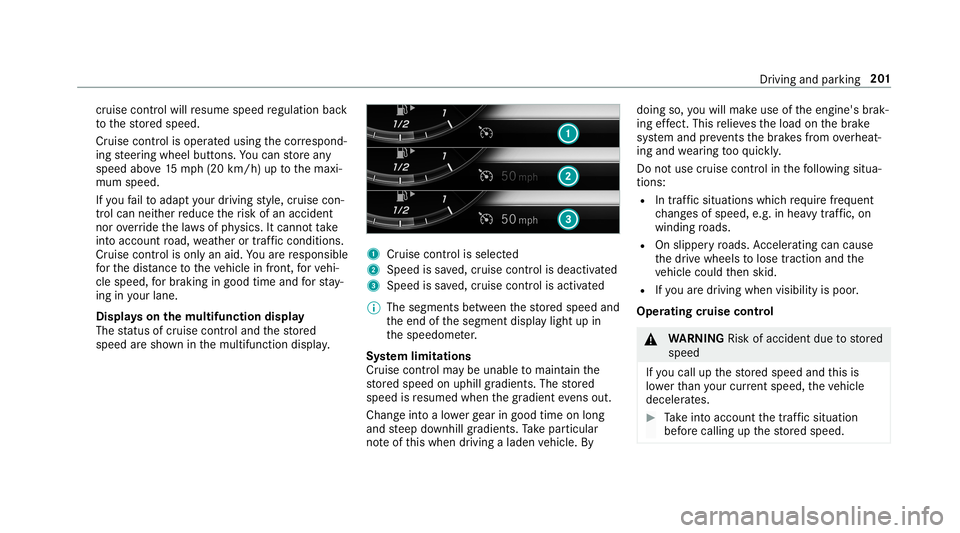
cr
uise contr olwillre sume speed regulation back
to thestor ed speed.
Cr uise controlis oper ated using thecor respond‐
ing steer ing wheel buttons. Youcan stor ean y
speed above15 mp h(2 0km/h) uptothemaxi‐
mum speed.
If yo ufa ilto adap tyo ur drivin gst yle, cruise con‐
tr ol can neither reduce therisk ofan accident
nor override thelaws ofphysics. Itcan nottak e
int oacc ount road, weather ortraf fic condi tions.
Cr uise contr olisonly anaid. Youar ere sponsible
fo rth edis tance totheve hicle infront, forve hi‐
cle speed, forbr aking ingood timeandforst ay ‐
ing inyour lane .
Disp lays on themu ltifunct iondisp lay
The status ofcruise control and thestor ed
speed aresho wninthemultifunc tiondispla y. 1
Cruise contro lis selec ted
2 Spee dis save d, cruise control isdeactiv ated
3 Speed issave d, cruise control isactiv ated
% The segmen tsbetween thestor ed speed and
th eend ofthesegment displaylight upin
th espeedome ter.
Sy stem limita tions
Cr uise control ma ybe unable tomaint ainthe
st or ed speed onuphill gradients. Thestor ed
speed isresumed whenthegr adient evensout.
Ch ang eint oalowe rge ar ingood timeon long
and steep downhill gradients. Take par ticular
no te ofthis when drivin galaden vehicle. By doing
so,youwill mak euse oftheengine' sbr ak‐
ing effect. Thisre lie vesth eload onthebr ak e
sy stem and preve nts thebr ak es from overheat‐
ing and wearing tooqu ickl y.
Do notus ecr uise contr olinthefo llo wing situa‐
tion s:
R Intraf fic situ ations whichrequ ire freq uent
ch ang esofspee d,e.g .in hea vytraf fic, on
wi nding roads.
R Onslippe ryroads. Accel erati ng can cause
th edr ive wheels tolose tract ion and the
ve hicle could then skid.
R Ifyo uar edr ivin gwhen visibilit yis poor .
Ope ratin gcr uis eco ntr ol &
WARNIN GRisk ofacci dent dueto stor ed
speed
If yo ucall upthestor ed speed andthis is
lo we rth an your cur rent spe ed,th eve hicle
deceler ates. #
Take intoacc ount thetra ffic situat ion
bef orecallin gup thestor ed speed. Dr
iving andparking 20
1
Page 205 of 578

Ac
tiv eDi stance AssistDI ST RO NIC Fu
nction ofActiv eDi stance Assist
DI ST RO NIC Ac
tiveDis tance AssistDIS TRONI Cma intains the
se tspeed onfree-f lowing roads. Ifve hicles in
fr ont arede tected, these tdis tance ismai n‐
ta ined, ifnec essar y,unt ilth eve hicle comes toa
halt. Thevehicle acceler ates orbrak es depend‐
ing onthedis tance totheve hicle infront and
th ese tspeed. Thespeed (inthera ng ebe twee n
15 mp h(2 0km/h) and130mp h(210 km/h) )
and thedis tance totheve hicle infront arese t
and save don thesteer ing wheel. Ot
her featur esofActiveDis tance Assist
DIS TRONI C:
R Adjus tsthedr iving style depending onthe
select eddrive pr ogr am (fuel-sa ving,comfort‐
able ordynamic) (→pag e17 5)
R React sto statio naryve hicles detected in
urb anspe edrang es (exc ep tbicy cles and
mo torcyc les)
R Initiates acc eler ation tothestor ed speed if
th etur nsignal indicat orisswitc hedonto
ch ang eto theove rtakin glane .
R Take sone-sided overtakin gre strictions into
acco untonhighwaysor on multi-lane roads
wit hseparat ero adw ays(countr y-dependen t).
Ve hicl eswith Activ ePa rking Assis t:ifth e
ve hicle hasbeen brak ed toast ands tillon mult i-
lane ,separ atero adw aysby ActiveDis tance
Assi stDIS TRONI C,itcan automatical lyfollo w
th eve hicle infront driving offag ain within
30 seconds. Ifacr itical situation isde tected
whe ndr ivi ng off,avis ualand acoustic warning is
giv en indic atingth at thedr iver mus tno wtake
contr olof theve hicle. Thevehicle isno tacceler‐
at ed anyfur ther. Ac
tiveDis tance AssistDIS TRONI Cis only anaid.
The driver isresponsible forke eping asaf edis‐
ta nce totheve hicle infront, forve hicle speed
and forbr aking ingood time.
Sy stem limita tions
The system maybe impair edorma yno tfunc tion
in thefo llo wing instances:
R Insno w,rain, fog, hea vyspr ay,if th er eis
gl ar e, indir ect sunlight oringreat lyvarying
ambien tlight .
R The windsh ieldinthear ea ofthecamer ais
dir ty,fo gg ed up, damag edorcovered.
R Ifth era dar sensor sar edir tyor covered.
R Inpar kingga rage sor on roads withsteep
uphill ordownhill gradients.
R Ifth er ear enar row vehicles infront, suchas
bicy cles ormo torcyc les.
In addition ,on slipper yro ads, brakin gor acc el‐
er atin gcan caus eon eor severalwheels tolose
tr act ion and theve hicle could then skid.
Do notuse ActiveDis tance AssistDIS TRONI Cin
th ese situation s. Dr
iving andparking 203